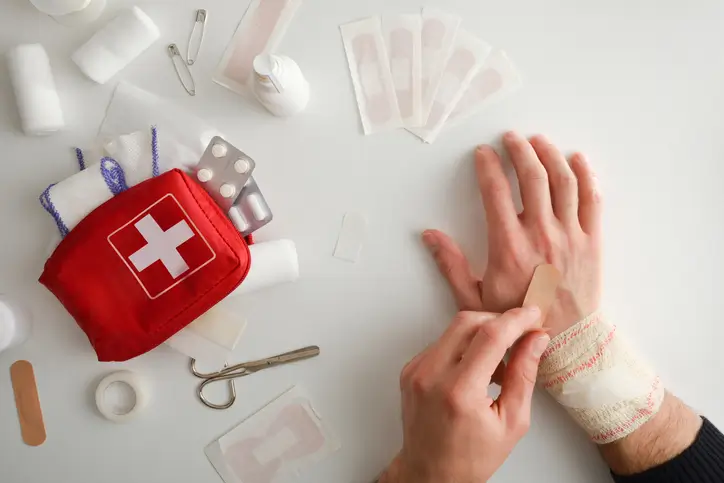Cuts & Puncture Wounds: Risks, Prevention, and First Aid
Cuts and puncture wounds are common injuries that can occur in various settings, from workplaces to homes. Understanding the risks associated with these injuries, implementing effective precautions, and knowing the appropriate response can significantly reduce the likelihood of complications.
Understanding Cuts and Puncture Wounds
A cut or laceration is an injury where the skin is sliced open, often caused by sharp objects like knives or glass. These injuries can range from minor scratches to deep wounds affecting muscles, nerves, or blood vessels.
A puncture wound, on the other hand, occurs when a pointed object, such as a nail or needle, pierces the skin, creating a small entry hole. While puncture wounds may not bleed heavily, they can be deep and pose a higher risk of infection due to the difficulty in cleaning them properly.
Risks Associated with Cuts and Puncture Wounds
Both types of injuries carry risks that can lead to serious health complications:
- Infection: Puncture wounds, in particular, provide a warm, moist environment conducive to bacterial growth, making them prone to infections
- Nerve and Tissue Damage: Deep cuts or punctures can damage underlying nerves, tendons, or muscles, potentially leading to loss of function or sensation.
- Tetanus: Puncture wounds caused by contaminated objects can introduce tetanus bacteria into the body, leading to a serious infection affecting the nervous system.
Precautions to Prevent Injuries
Preventing cuts and puncture wounds involves a combination of proper training, the use of appropriate personal protective equipment (PPE), and adherence to safety protocols:
- Use Personal Protective Equipment (PPE): Wearing cut-resistant gloves, safety glasses, and appropriate footwear can provide a barrier against sharp objects.
- Maintain Tools and Equipment: Regularly inspect and maintain tools to ensure they are in good working condition. Dull blades or faulty equipment can increase the risk of injury.
- Implement Safety Procedures: Establish and follow standard operating procedures for tasks involving sharp objects or machinery. Ensure all employees are trained in these procedures.
- Promote Good Housekeeping: Keep work areas clean and free of clutter to prevent accidental injuries from hidden sharp objects.
- Use Proper Tools for the Job: Avoid using makeshift tools or using tools inappropriately, as this can lead to accidents.
- Stay Focused and Avoid Shortcuts: Encourage workers to stay attentive and avoid rushing through tasks, as haste can lead to mistakes and injuries.
Responding to Cuts and Puncture Wounds
Immediate and appropriate response to these injuries can prevent complications:
- Wash Your Hands: Before treating any wound, clean your hands thoroughly to prevent introducing bacteria into the injury.
- Stop the Bleeding: Apply gentle pressure with a clean cloth or bandage to control bleeding.
- Clean the Wound: Rinse the wound with clear water for 5 to 10 minutes to remove debris. If dirt remains, gently scrub with a clean washcloth. Seek medical attention if debris cannot be removed.
- Apply Antibiotic Ointment: Apply a thin layer of antibiotic cream or ointment to prevent infection. Monitor for any allergic reactions, such as a mild rash, and discontinue use if they occur.
- Cover the Wound: Use a sterile bandage to protect the wound from dirt and bacteria.
- Change the Dressing Regularly: Replace the bandage daily or whenever it becomes wet or dirty to promote healing.
- Monitor for Signs of Infection: Seek medical attention if you notice increased pain, redness, swelling, pus, or fever, as these may indicate an infection.
When to Seek Medical Attention
While many minor cuts and puncture wounds can be managed at home, certain situations require professional medical evaluation:
- Uncontrolled Bleeding: If bleeding persists despite applying pressure.
- Deep or Large Wounds: Especially if they expose muscles, bones, or organs.
- Wounds Caused by Animal or Human Bites: These have a higher risk of infection.
- Signs of Infection: Such as increased redness, swelling, warmth, or pus discharge.
- Tetanus Risk: If the wound is deep, contaminated, and your tetanus vaccination is not up to date.
Long-Term Care and Healing
Proper wound care doesn’t end once the injury is covered. To ensure optimal healing, it’s important to maintain a healthy diet rich in vitamins like Vitamin C and Zinc, which support tissue repair.
Staying hydrated and getting enough rest also play a crucial role in the body’s ability to heal. If a wound leaves a scar, applying silicone gel or vitamin E oil can help reduce its appearance over time.
Additionally, for deep cuts or puncture wounds, follow up with a healthcare professional to assess healing progress and prevent long-term complications such as nerve damage or stiffness.
Conclusion
By understanding the risks associated with cuts and puncture wounds, taking proactive preventive measures, and responding appropriately when injuries occur, individuals can significantly reduce the likelihood of complications and promote faster healing.








